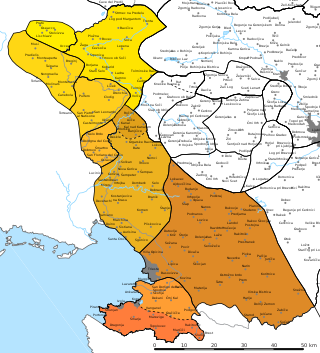
The Great Vowel Shift was a series of changes in the pronunciation of the English language that took place primarily between 1400 and 1700, beginning in southern England and today having influenced effectively all dialects of English. Through this vowel shift, the pronunciation of all Middle English long vowels were changed. Some consonant sounds also changed, particularly those that became silent; the term Great Vowel Shift is sometimes used to include these consonantal changes.
A diphthong, also known as a gliding vowel, is a combination of two adjacent vowel sounds within the same syllable. Technically, a diphthong is a vowel with two different targets: that is, the tongue moves during the pronunciation of the vowel. In most varieties of English, the phrase "no highway cowboy" has five distinct diphthongs, one in every syllable.
Old Irish, also called Old Gaelic, is the oldest form of the Goidelic/Gaelic language for which there are extensive written texts. It was used from c. 600 to c. 900. The main contemporary texts are dated c. 700–850; by 900 the language had already transitioned into early Middle Irish. Some Old Irish texts date from the 10th century, although these are presumably copies of texts written at an earlier time. Old Irish is thus forebear to Modern Irish, Manx and Scottish Gaelic.
Like many other languages, English has wide variation in pronunciation, both historically and from dialect to dialect. In general, however, the regional dialects of English share a largely similar phonological system. Among other things, most dialects have vowel reduction in unstressed syllables and a complex set of phonological features that distinguish fortis and lenis consonants.
There is significant phonological variation among the various Yiddish dialects. The description that follows is of a modern Standard Yiddish that was devised during the early 20th century and is frequently encountered in pedagogical contexts.
The phonology of Quebec French is more complex than that of Parisian or Continental French. Quebec French has maintained phonemic distinctions between and, and, and, and. The latter phoneme of each pair has disappeared in Parisian French, and only the last distinction has been maintained in Meridional French, yet all of these distinctions persist in Swiss and Belgian French.
Dutch phonology is similar to that of other West Germanic languages, especially Afrikaans and West Frisian.
Unlike many languages, Icelandic has only very minor dialectal differences in sounds. The language has both monophthongs and diphthongs, and many consonants can be voiced or unvoiced.
Monophthongization is a sound change by which a diphthong becomes a monophthong, a type of vowel shift. It is also known as ungliding, as diphthongs are also known as gliding vowels. In languages that have undergone monophthongization, digraphs that formerly represented diphthongs now represent monophthongs. The opposite of monophthongization is vowel breaking.
The phonology of Faroese has an inventory similar to the closely related Icelandic language, but markedly different processes differentiate the two. Similarities include an aspiration contrast in stop consonants, the retention of front rounded vowels and vowel quality changes instead of vowel length distinctions.

This article uses Logar transcription.
Binandere is a Papuan language spoken in the "tail" of Papua New Guinea.
Aion a.k.a. Ambakich is a Keram language of Papua New Guinea. It is only spoken by adults; children grow up speaking Tok Pisin.
The phonology of Old Saxon mirrors that of the other ancient Germanic languages, and also, to a lesser extent, that of modern West Germanic languages such as English, Dutch, Frisian, German, and Low German.
This article is about the phonology and phonetics of the West Frisian language.

The Phonetic Journal was the official journal of The Phonetic Society based at the Kingston Buildings in Bath, Somerset, England and is the first ever journal about phonetics. It was published subtitled as Published Weekly, Devoted to the Propagation of Phonetic Shorthand, and Phonetic Reading, Writing and Printing.

Niʻihau dialect is a dialect of the Hawaiian language spoken on the island of Niʻihau, more specifically in its only settlement Puʻuwai, and on the island of Kauaʻi, specifically near Kekaha, where descendants of families from Niʻihau now live. Today, the Niʻihau dialect is taught in Ke Kula Niihau O Kekaha.
Monophthongization of diphthongs is a Proto-Slavic sound change in which diphthongs turn into vowels. It is one of the key events in the chronology of the Proto-Slavic language. The monophthongization of diphthongs restructured the Proto-Slavic language with a strong influence on its morphophonology.
The diaeresis is a diacritical mark used to indicate the separation of two distinct vowel letters in adjacent syllables when an instance of diaeresis occurs, so as to distinguish from a digraph or diphthong.




